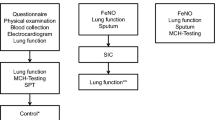Abstract
Objective: Nitric oxide (NO) levels in the exhaled air of asthmatic patients have been shown to be increased. This observation has also been reported in workers who are allergic to laboratory animals. To determine if a challenge test with natural rubber latex (NRL) or 4,4′-diphenylmethane diisocyanate (MDI) would also produce an increase of NO exhalation in sensitized patients, we carried out this study. Methods: Nine subjects with suspected occupational asthma were exposed to MDI, and 18 took part in a challenge test with gloves powdered with NRL. Nineteen subjects underwent a challenge test with methacholine (MCh). Exhaled NO was measured by a modified chemiluminescence analyzer according to the European Respiratory Society guidelines. Results: We found that there was a decrease in exhaled NO concentrations 16–18 h after MCh challenge testing and subsequent bronchodilation with salbutamol, in three subjects. Three of nine participants had a significant immediate bronchial obstruction after exposure to MDI, of those three, two had MDI-specific IgE antibodies. After 22 h, their levels of exhaled NO had increased >10 parts per billion (ppb). Eight of the 18 subjects participating in the NRL challenge test displayed an NO concentration increase of at least 10 ppb after 22 h (seven had NRL-specific IgE antibodies). A significant decrease in the one-second forced expiratory volume (FEV1) was documented in four of those eight participants after NRL challenge. Conclusions: There was no clear relationship between bronchial response, substance-specific IgE antibodies and an increase in exhaled NO levels. However, there was a tendency for subjects with substance-specific IgE antibodies and bronchial reaction to develop an increase in exhaled NO concentration. Further studies are needed to determine if analysis of NO from the lower respiratory tract can become a useful non-invasive tool for detecting lower airway inflammatory response even before clinical symptoms occur.
Similar content being viewed by others
Author information
Authors and Affiliations
Additional information
Received: 19 May 1999 / Accepted: 20 November 1999
Rights and permissions
About this article
Cite this article
Allmers, H., Chen, Z., Barbinova, L. et al. Challenge from methacholine, natural rubber latex, or 4,4′-diphenylmethane diisocyanate in workers with suspected sensitization affects exhaled nitric oxide [change in exhaled NO levels after allergen challenges]. Int Arch Occup Environ Health 73, 181–186 (2000). https://doi.org/10.1007/s004200050025
Issue Date:
DOI: https://doi.org/10.1007/s004200050025




